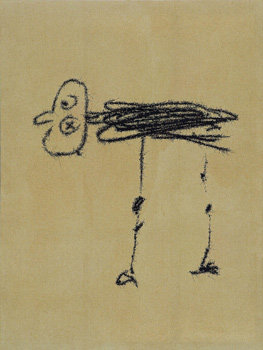Ye Yongqing
dal 4/4/2008 al 18/4/2008
Segnalato da
4/4/2008
Ye Yongqing
Hong Kong Arts Centre, Hong Kong
As Free as a Bird. A retrospective of the artist's work from the past 30 years. Ye Yongqing is perhaps best known for his bird paintings, which he began in 2000. These are executed in a quirky style featuring scratched black lines using the traditional medium of Chinese brush and ink on rice paper.

Anna Ning Fine Art is delighted to announce its forthcoming solo exhibition of paintings by the renowned Chinese artist Ye Yongqing. The exhibition will be a retrospective of Ye Yongqing’s work from the past
30 years.
When Picasso wrote “Painting is just another way of keeping a diary”, he did not mean that art recorded a catalogue of events; rather that art was his way of expressing his feelings about life and the nature of life itself. Ye Yongqing (b. 1958), one of the most prominent figures in contemporary Chinese art, has a similar philosophy and approach to art and life.
From his childhood in Yunnan Province, Ye Yongqing’s art and life have been closely intertwined. He has consistently bucked trends and followed his own path, making him one of the most distinctive and individual Chinese artists of his time. Ye Yongqing was born in Kunming, Yunnan Province, in 1958 and graduated from the Oil Painting Department of the Sichuan Academy of Fine Arts, Chongqing in 1982. During the 1980s, he joined the New Wave Arts movement, becoming a leading figure of the influential “Southwest Art Group” which also included such significant artists as Mao Xuhui, Zhou Chunya and Zhang Xiaogang. Today, as well as being an artist, Ye Yongqing is an Associate Professor at the Sichuan Academy of Fine Arts, a well-known curator and exhibition organizer. He is also the founder of the Upriver Gallery and Self-Run Space in Chengdu and the Loft in Kunming.
Ye Yongqing is perhaps best known for his bird paintings, which he began in 2000. These are executed in a quirky style featuring scratched black lines using the traditional medium of Chinese brush and ink on rice paper. Some paintings are very large, and are achieved by using a projector to beam simple sketches of birds in the artist’s notebook onto canvas or paper. Then he traces the enlarged shapes using a thin brush to draw abstract lines. At first sight, one might say that Ye Yongqing’s birds look like childish scribbles, lacking in refined skill; yet on closer examination they turn out to be very delicate and beautiful.
The leading art critic Li Xianting has described Ye Yongqing as “a poet with literary talent in his bones”. Ye Yongqing was influenced by Western masters, especially Cezanne, and later discovered the metaphysical painting of De Chirico and the surrealism of Dali. However, while other Chinese artists idolized the West and followed the path of “Political Pop”, Ye Yongqing rejected both Westernization and modernism, moving instead towards to a more inward-focused self-analysis.
In the 1990s, after traveling to the USA and Europe, he made collages that assembled images of trivial daily life – bird cages, light bulbs, pipes, cars, old photographs, caricatures – drawing them in the casual manner of Chinese literati artists. These paintings were divided into sections like a big cartoon describing his life with his own language and icons. He wrote, “I often see my life as like that of a migratory bird moving among several different cities, fragmented and with no fixed abode. I paint and put together my creations the
same way.”
The bird has become Ye Yongqing’s personal form of symbolic expression, a reflection of his spirit and emotions. By using the medium of traditional Chinese brush and ink but with a detached sense of freedom from literati paintings, Ye Yongqing seems to revive his life and spirit in his bird paintings – as a painter as free as a bird.
Hong Kong Arts Centre
2 Harbour Road - Hong Kong



